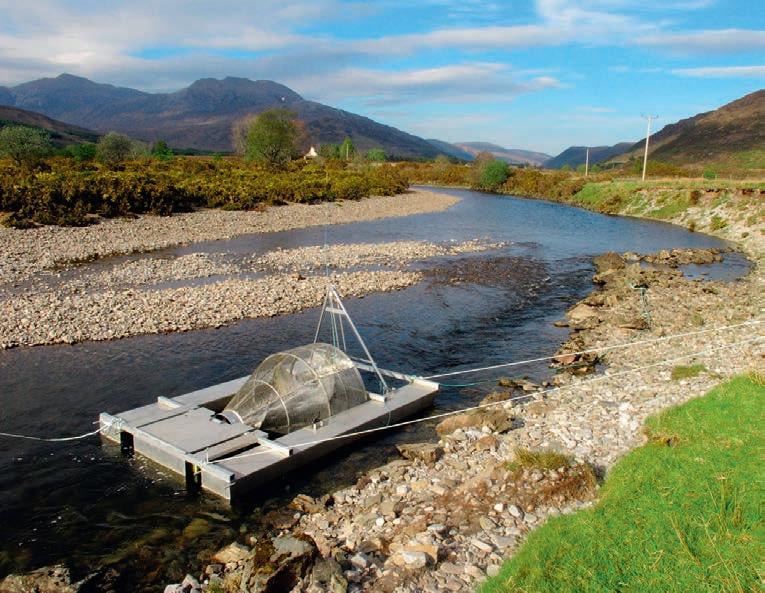
9 minute read
Robert Outram on the River Carron restocking project

Back from the brink






A new study suggests that captive breeding to restore native stock can help to revive ailing wild salmon populations



BY ROBERT OUTRAM







CAN stocking programmes offer a lasting solution to the problem of declining fi sh numbers in Scotland’s salmon rivers? A recent study carried out by a team at the University of the Highlands and Islands sought to answer that question.
During the 1990s, the River Carron in Wester Ross saw a dramatic decline in salmon numbers. The owners, Riparian, with biologist and keen salmon fi sherman Bob Kindness, set up the River Carron Conservation Association, which has been adding to the wild stock since 1995.
The stocked fi sh are all native to the Carron. Initially stocking was carried out using eggs stripped from wild salmon hens, but the available numbers were quite limited. From 2001, the association has been using captive broodstock – all Carron fi sh – to bring the numbers of fry released up from 5,000–10,000 to 150,000 or more.
Judging by recorded catches, the number of salmon in the Carron has gone up steeply, increasing from a fi ve-year annual average of 10.6 in 2001 to 187.2 in 2020, according to Marine Scotland Science (MSS).
MSS does not support stocking from captive broodstock, however, as Bob Kindness explains: “If a river’s salmon stock is low, the only way to obtain enough eggs for stocking to be effective,is to create a captive broodstock as insuffi cient wild brood fi sh can be taken from the river.” MSS is also against stocking out young fi sh beyond the un-fed stage. Kindness adds: “There is a suggestion that any fi sh that is reared in captivity before release loses its ability to cope in the wild. MSS believes that if you rear fi sh in tanks they become domesticated - they can’t feed
in the wild and they can’t avoid predation.” So,could the increase in salmon numbers be attributed to the stocking programme or was it due to some other cause? One way to fi nd out was to see how many of the adult fi sh and smolts in the river were from the programme. Tagging or otherwise marking fi sh is intrusive so it was decided to use DNA analysis. The Rivers and Lochs Institute at Inverness College, University of the Highlands and Islands (UHI), have now analysed the DNA from three years of salmon catches. The results were then compared with DNA from the salmon broodstock used in the stocking programme to fi nd out whether the stocked juvenile fi sh were surviving to return as adults. They compared samples from fi sh in the river with records of the 2014 broodstock. The latter actually comprised three groups: two separate groups of captive broodstock and one “wild” group hatched from eggs stripped from wild fi sh and fertilised in the hatchery. They were able to do this because Kindness has been collecting samples for DNA analysis from catches on the river over the past decade by clipping a small piece from each salmon’s tail fi n. As well as adults returning from the sea to spawn, the team also analysed DNA from smolts caught in a screw trap on their way out to sea.











Left: Bob Kindness with HRH Prince Charles Above: Bob Kindness in the River Carron Below: Loch Sgabhain, source of the Carron Top right: Stripping eggs from a small wild grilse hen Right: The screw trap in posi� on towards the lower end of the river
The UHI team found that of the adult returners during 2017 to 2019, up to 27.7% originated from the 2014 broodstock that had been released as fry in 2015. Since the analysis did not include broodstock from 2013 and 2015, this almost certainly underestimates the proportion of stocked fi sh, which Kindness believes could be around 40–50% in total. There are two important conclusions from the report. First, it is apparent that stocking has contributed substantially to the increase in the Carron’s salmon population.
Second, the UHI team concludes: “We observed no major differences in measures of genetic diversity and inbreeding between the three broodstocks [two captive and one “wild”], their offspring, and other fi sh trapped in the river. Thus there is no indication that the 2014 stocking presented a risk to the genetic diversity of Carron Atlantic salmon as a whole.” The fact that there was very little difference in the performance of the
“captive” and “wild” broodstocks suggests that fi sh raised in hatcheries from captive broodstock do not suffer any inherent disadvantage.
The research vindicates the strategy adopted by Kindness and the River Carron Conservation Association. But does it have lessons for other depleted salmon rivers? The offi cial view is that restoring river habitats is the answer. Others suggest that simply removing salmon farms will help restore wild populations, although the presence of several farm sites in the Carron system does not appear to have prevented the recovery. Kindness says: “We keep being told that stocking doesn’t work. Instead, you should improve the habitat and plant trees. If you have a degraded habitat, that will help, but if you have a good habitat, as we did, with no problems apart from the winter spates, you can’t do much about it. “We had an almost pristine river, but there were no fi sh.” The Carron’s riverside environment and water quality were in good shape in the 1990s, but fi sh numbers were still tumbling before the stocking programme. Kindness believes there were two key challenges: fi rst, increasing predation by the salmon’s natural enemies; and, second, the increasing severity of “spates” – short-lived but intense fl oods caused by heavy bursts of rain.
Spates are a particular problem for the shorter rivers along Scotland’s west coast and they can wash away the gravel in which wild salmon lay their eggs, preventing them from hatching. Intense but sporadic rainfall appears to be becoming more common thanks to climate change and deforestation can also make fl ooding more of a problem, Kindness says. This, he explains, is one of the reasons why stocking with established fry is so important: it gives the salmon a chance to develop as fry before they have to take their chances in the river. Could other rivers, then, emulate the Carron project? Stocking in this way does not require a huge capital investment, Kindness argues. As he puts it: “I have no buildings, I don’t use electricity. We use gravity-fed water and simple tanks. It’s not like a big commercial farming operation. “What’s more important is to have someone who knows what they’re doing.” In addition to the stocking programme, the owners of the Carron, Riparian, has worked to improve the biodiversity of the glen through which the river runs and to mitigate the water runoff that contributes to spates. Some 370,000 trees have been planted on the Glencarron Estate alone.
The next stage is to extend the research to get a broader picture. The report stresses that continued analysis will provide essential further insight – however, genomic analysis costs money. Kindness says: “Knowing now that the DNA analysis can tell us so much more about the effects of stocking, the next stage of the project is for UHI to analyse the data from a much larger number of samples of DNA that we hold. This will be an expensive undertaking and we need help to fund the RLI to do that work. “We are pretty confi dent that there are enough salmon enthusiasts and river owners interested in the conservation of Atlantic salmon to raise the funds to do this. We are so lucky to have a university right on our doorstep to help us with this work and together we can lead the way in developing the science to help fi ght the decline of Atlantic salmon.” FF



























